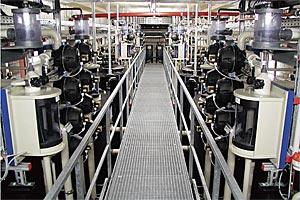Robert-Bosch Hospital, Stuttgart


The holding and decay plant has been designed to treat radioactive wastewater from nuclear medical therapies at the Robert-Bosch Hospital in Stuttgart, Germany.
By decay, the radioactive wastewater from the control area of the ten-bed ward is brought to the limit values defined by the German Radiation Protection Ordinance. The plant has been designed to suit the daily wastewater production of 680 litres and the annually administered activity of 175 GBq.
12 tanks with a holding capacity of 10 m³ each are available. In order to conserve radioactive wastewater, a special vacuum technology and a washing water recycling system are used.
Additionally, the plant features a fully automatic control system for the fresh water consumption in the patients' rooms.
In order to avoid aerobic and anaerobic processes, the tanks are equipped with a special ventilation system.
Before introduction of the decayed wastewater into the sewers, its radioactivity is measured automatically for logging purposes and for submittal to the authorities. It is also possible to calculate the introduction date for the tanks holding wastewater that has not yet been decayed.
The flowchart on the electric and control cabinet allows the reading of the operating modes of the individual aggregates and valves. It is further possible to control the plant via a panel PC (see photo) providing a graphic display of the operating modes. Thus, provided a network is available, the operator can monitor and control the plant from any place inside the building.
Even the connection of laptops per modem and telephone line, as required by the Leipzig Hospital, is possible.
The relevant DIN and radiation protection ordinances valid for this kind of plant are of course strictly adhered to.
Brochure download



